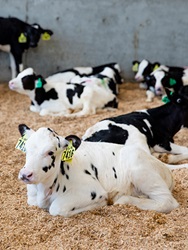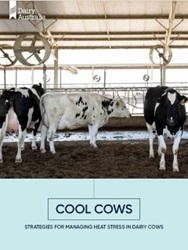Compost Bedded Pack Structures
While compost bedded pack structures call for different uses of time and money, they provide many benefits for dairy farmers in dryer and warmer climates.
In recent years, composted bedding packs as a loafing area surface have become more common on Australian dairy farms.
The basis for these shelters is the use of bedding that can promote the composting of cow manure into the bedding of the shed.
This is achieved by using a deep bedding that can be aerated on a daily basis.
Building or modifying a bedded pack structure may be in response to changes in farming systems, such as feeding rations, paddock rotations or a bigger herd. Considerations of potential heat stress impacts from the composting process should inform the decision-making around bedded pack structure design and maintenance.
From a heat stress management perspective, a compost shed will be able to handle high levels of animal traffic better than a few shaded paddocks over the summer.
Many farmers report using a few sacrifice paddocks over the summer that have some shade. The paddocks are used until mastitis levels start to increase then another paddock is found. A compost barn is an alternative to sacrifice paddocks.
It is still unclear how effective compost bedding pack systems will be in hot humid areas of Australia, such as coastal Queensland, especially if using dry manure solids as compost bedding. It is important that the bedding pack does not get too wet as this will kill the composting bacteria. In humid climates this is a challenge.
A recent investigation into the experiences of eleven Australian dairy farmers showed that heat stress issues had decreased on most of the compost bedding pack shelter farms visited. However, some farms have cows that are still experiencing some heat stress (in Victoria and Queensland) and some farmers are considering using fans in hot periods (Chamberlain, 2018).
It remains unclear if the heat generated from microbial activity causes more heat stress when cows are lying down, but it is assumed that some heat transfer will occur from the pack to the cow when the cow is lying down, possibly adding to heat stress or willingness of cows to lay down during periods higher environmental temperatures.
Strengths
- Compost bedded pack structures are flexible in use, if appropriately designed and managed to support higher levels of cow comfort and include appropriate space allocation for a hospital herd, breeding and calving etc.
- Potential to mitigate risks to high-producing herds from seasonal weather variability and long-term changes in climate systems.
- Low capital outlay and maintenance costs, although they present new management challenges, such as staff training and changes in labour use.
Limitations
- Larger herds can become difficult to accommodate if using compost bedded packs.
- Excellent management of mastitis is required. The cows should be properly prepared and teat preparations applied after milking.
- Poorly ventilated structures resulting in high bed moisture content can increase the risk of environmental mastitis in humid conditions.
- Bedding materials can fluctuate in price through changes in availability.
- Summer storms in warmer months with higher than normal rainfall can wet the bedding.
Keys to success
- Make sure staff are well trained in identifying issues and understanding the processes of bedded structures, such as monitoring moisture and bedded pack tilling, along with extra steps (if required) in milking management, teat preparation & spraying.
- Reduce water/mud splashing on return to feed bunk to reduce mastitis or compost bedding contamination. Keeping cows standing for 1hr following milking is advisable.

